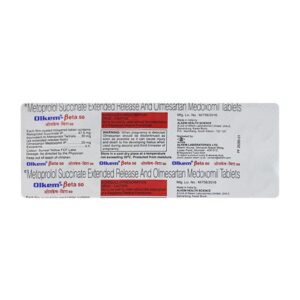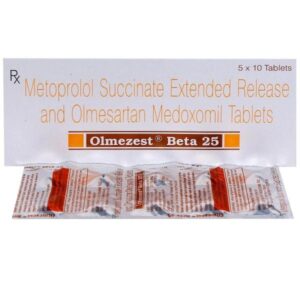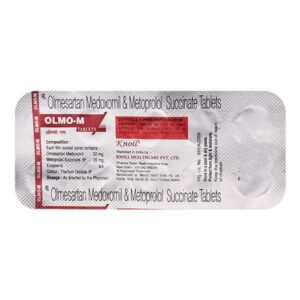METOPROLOL + OLMESARTAN
Metoprolol: Metoprolol is a medication classified as a beta-blocker that is commonly used in the treatment of high blood pressure, chest pain (angina), heart failure, and certain types of irregular heart rhythms.
Its mechanism of action involves blocking the effects of adrenaline (epinephrine) on the beta-adrenergic receptors in the heart, blood vessels, and lungs. By doing so, it helps to slow down the heart rate, reduce the force of contractions, and lower blood pressure. This ultimately decreases the amount of work the heart has to do and improves its efficiency.
The starting dose of metoprolol and the subsequent maintenance dose can vary depending on the condition being treated and individual patient characteristics. Usually, the starting dose for high blood pressure is 25-100 mg once daily, which may be gradually increased if blood pressure does not adequately respond. For chest pain, the usual dose is 50 mg twice daily or 100 mg once daily. For heart failure, the initial dose is usually lower and titrated upwards. It’s important to follow the prescribed dosage and consult with a healthcare professional for appropriate dosing instructions.
Like any medication, metoprolol can have side effects. Common side effects may include fatigue, dizziness, low blood pressure, slow heart rate, and cold hands and feet. It may also cause gastrointestinal disturbances such as nausea, vomiting, and diarrhea. Occasionally, it may lead to sleep disturbances, depression, or impotence. Rarely, metoprolol can cause more serious side effects such as wheezing or difficulty breathing in patients with asthma or chronic obstructive pulmonary disease (COPD). It’s crucial to discuss any concerns or side effects with a healthcare professional.
It’s important to note that metoprolol can interact with other medications, particularly those that also affect heart rate or blood pressure. It is always recommended to inform healthcare professionals about all medications, supplements, and health conditions before starting metoprolol to ensure safe and effective use.
Olmesartan: Olmesartan is a medication that belongs to a class of drugs known as angiotensin II receptor blockers (ARBs). It is primarily used in the treatment of high blood pressure (hypertension) to help lower blood pressure and reduce the risk of heart attack and stroke.
The mechanism of action of Olmesartan involves blocking the action of angiotensin II, a hormone that causes blood vessels to narrow, thereby promoting vasoconstriction and raising blood pressure. By inhibiting angiotensin II, Olmesartan relaxes blood vessels, allowing them to widen and improving blood flow, thereby reducing blood pressure.
The typical dose of Olmesartan for hypertension is usually 20 mg taken once daily. The dose may be increased to a maximum of 40 mg per day if necessary. It can be taken with or without food.
Common side effects of Olmesartan include dizziness, headache, stomach pain, diarrhea, back pain, and fatigue. These side effects are usually mild and temporary. However, if any severe or persistent side effects occur, it is important to seek medical attention.
In rare cases, Olmesartan may cause more serious side effects such as low blood pressure, allergic reactions (rash, itching, swelling, severe dizziness), and kidney problems. If any of these symptoms occur, it is important to stop taking the medication and seek immediate medical help.
It is important for patients to follow their healthcare professional’s instructions regarding the use of Olmesartan, as it may interact with other medications or conditions. Additionally, pregnant women or those planning to become pregnant should avoid using Olmesartan, as it may cause harm to the fetus.



